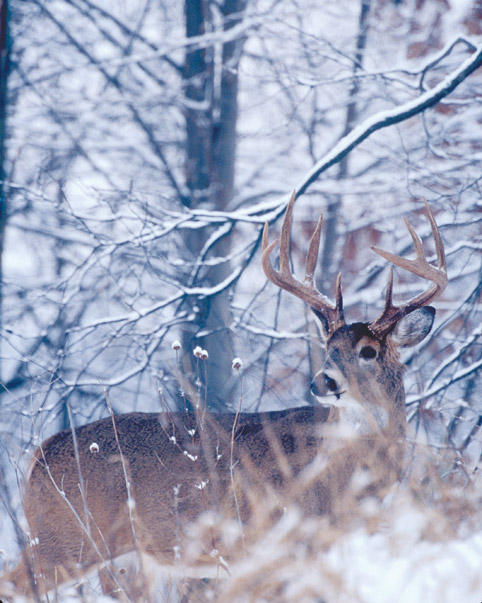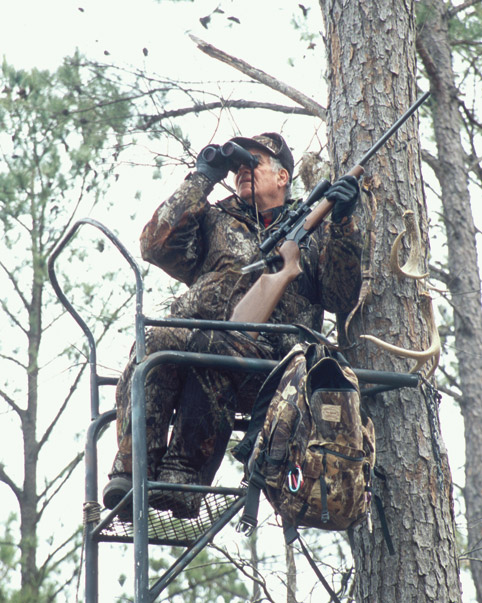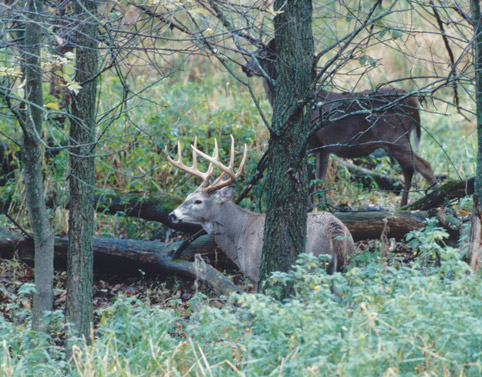 Whitetail Head Hunters
Whitetail Head Hunters 
By Hunting Editor Judd Cooney

The buck appeared as a lighter shadow, barely visible in the dense brush on the far side of the food plot. He stood like a statue for a full 10 minutes, cautiously surveying the alfalfa field where several does and an 8-pointer already were munching the lush vegetation. I had him centered in the field of my window-mounted spotting scope from 400 yards across a harvested bean field.
When he finally stepped out and gave me a good look, I yelped, "Holy Hannah! Would you look at the size of those antlers!" No doubt about it; I was looking at a candidate for the Boone & Crockett book.
And then the big buck cautiously eased his way right under a tree stand that overlooked the trail he was taking. Unfortunately, my closest bow-hunting client was sitting in another tree on the other end of the property. But if any one of the four clients I had in camp was willing to spend the next three evenings in that tree stand, I figured he'd get a shot at the buck of a lifetime.
Yet that night at camp, I learned that no one wanted to move. One of the four had arrowed his buck earlier that evening, and the other three all reported seeing 'shooters' from their stands. The hunter who was on the far end of the same property where I had seen the boomer buck said that he had seen several smaller bucks and one wall hanger.
However, after much cajoling, he finally agreed that if he didn't tag out the next morning, he would move to hunt the big buck the following evening. And he did spend the next evening in the stand the big buck had ambled under. But he didn't see any deer, and he insisted on returning to his earlier stand. To add insult to injury, one of my guides videoed the huge buck as he walked under that same tree stand the very next evening. I figured there was a good chance someone would take the buck later during firearms season, but nobody saw him. Maybe next year.
There's deer hunting, and then there's hunting for trophy bucks. Deer may be found just about anywhere nowadays, but true trophy bucks still are the rare exception. If you really want to tag a trophy, whether you hunt in your own backyard or book a hunt with an outfitter, you need to consider the trophy potential of the hunting area. It doesn't do much good to hold out for a 140-class buck in an area where the chances of seeing such a buck are slim and none. You also must honestly consider your own hunting experience, ability, and dedication to the task.
Several years ago, a bow-hunting client who had studied our website in detail for the two years it took him to get an Iowa license said he was locked onto the fact we'd reported seeing the same 190-class buck each year for several years running. He informed me that he wanted to hunt that deer.
I told him that was fine with me, and then I carefully explained that he'd be bow-hunting the trails and travelways that buck used, where he wasn't likely to see lots of other deer. Some trophy bucks prefer to walk alone.
It didn't take long after the hunter arrived to realize I had a real problem on my hands. He was overweight and suffered respiratory problems that limited his walking to no more than a few hundred yards, yet he wouldn't ride on a 4-wheeler, either. He wouldn't get into a tree stand, and he did not shoot a practice arrow during the six days he was in camp. His attitude was poor. In fact, he was totally negative from day one. He told me he had bowhunted in his home state for 20 years without tagging a single deer.
Not exactly the ideal candidate to stack up against a once-in-a-lifetime buck.
He lasted one day hunting the big buck behind the house and then was ready to shoot any buck. After missing a nice buck at 20 yards from a pit blind dug especially for him he was ready to take any deer that got within bow range.
I spend a lot of time on the phone conversing with clients about just what they want in the way of a deer. I've had prospective clients specifically ask about the chances of shooting a Pope & Young bow buck, but when I asked, they didn't have the slightest idea what the minimum size might be, and then admitted that they really hadn't given much thought to field judging antlers. If you want a Pope & Young buck, you better be able to tell the difference between a buck that will score 110 and one that will score 125.
Either will look mighty tempting in the woods.
I make it very clear to clients, especially first-timers, that the only person they have to please on their hunt is themselves. If they are hoping to impress me or anyone else, they are on the wrong track.
But if they are serious about taking a trophy buck, one of the things they must accept is that they probably are not going to see as many deer as the guy who says he would be happy just putting meat in the freezer.
Every fall hunters arrive in our camp firmly committed to the idea of hunting only the locations where the big bucks are most likely to travel and be seen, those out-of-the-way places where a hunter may not see many or even any other deer during a day on stand. Usually, this is all fine and good until the second or third day in camp. After listening to the other hunters describe seeing lots of deer, including some decent bucks, the would-be trophy hunter's fortitude starts to erode, and he asks to try somewhere new. Occasionally, a hunter learns the hard way about abandoning trophy dreams.
Last fall a group of experienced hunters came to camp, and on opening day of firearms season, I tried to put each hunter in a stand where he had a chance at the type of buck he had said he'd be satisfied taking, which varied from a decent 8-point to nothing less than a 10-point scoring 160 or better. I placed one of the more particular trophy hunters in a ladder stand overlooking an open creek bottom and dry pond bed, a location that has been one of our best trophy producers.
This stand is a bit unusual for a trophy hot spot, in that it also is a place where a hunter is likely to see a lot of deer. During opening weekend, the neighbors push a lot of deer off their farms, through this natural crossing and onto our timbered and protected leases. Even though the hunter saw more than 50 deer move past his stand, he didn't see any 'shooters' and decided he wanted a change of scenery. It was his hunt and his choice, so I moved him to another location the following day.
But knowing the history of the stand, I confidently convinced Dick Metcalf, a knowledgeable whitetail hunter with a number of trophy bucks already to his credit, that this particular stand was one of the best on all of our leases. The following morning, I walked Dick into the stand long before daylight.
When I radioed him at noon to check in, he said he'd only seen a single deer. I offered to move him to another stand for the afternoon, but he replied laconically, "Not unless you can pick me up another license."
Then he explained that shortly before 11, he had heard crunching leaves behind his stand. A few minutes later, a huge buck had walked within a few yards of the stand's base and then had stood surveying the narrow draw, less than 10 yards from the motionless hunter. That's when Dick's experience and self-discipline kicked into muscle-locking overdrive.
He sat like a stone as the deer crossed the open bottom and then stopped on a 4-wheeler trail along the far side of the draw. At that point, Dick slowly eased his shotgun into shooting position. At 30 yards, the Buckhammer slug from his 20 gauge Remington 11-87 dropped the heavily antlered 175-point buck and made both Dick's day and mine.
If you are going to pay for a guided hunt, it only makes sense to listen to what the guide says. I can't believe how hard it is to convince some clients to rattle and grunt call on a regular basis while they are on stand — regardless of the time of season. The bowhunter who sat one evening in the stand where I'd seen the monster buck refused to rattle or grunt call, because he didn't have confidence in his ability and felt he'd do more harm than good. Hogwash. His reticence may have cost him a chance at bringing the big buck out of the impenetrable bedding area and within bow range.
Others give rattling or grunt calling a half-hearted try, and when they don't get immediate results, they conclude that it doesn't work. They seem to operate on the adage: If at first you don't succeed, quit or you might really screw things up.
Several years ago during the pre-rut, I spent three mornings bowhunting a dense river bottom along the Missouri River. The first two mornings I rattled and grunt called every 20 minutes from daylight until 9 a.m., and several small bucks appeared within bow range along with a very respectable 10-point, that, in hindsight, I should have taken a shot at. The third morning I kept rattling, but the only thing I saw was an opossum that got my heart to pumping when he came rustling and rattling the leaves behind my tree stand.
I began to think that I'd burned out the stand by overdoing the rattling and calling, but since the pre-rut was in full swing, I knew that a new buck was likely to be moving along the river bottom at any time. I convinced myself to stay an extra hour.
At five minutes 'til 10, I started crashing the antlers together with a vengeance, scraping the tree and grunting along with the rattling. I was determined to get the message out to any bucks within hearing that there was competition in their realm, or at least a really entertaining fight to come watch.
I'd just turned to hang the antlers on a hook when the sound of thrashing antlers jerked my attention to the scrape directly below my perch. Where that buck came from, and how it got where it was without my seeing, I'll never know. But there he was in all his fury, thoroughly thrashing the lower branches over the scrape. I managed to get my bow off the hanger without being detected, but then my mental faculties shorted out and my self-discipline failed. As the hefty 10-pointer walked up the trail in front of my stand, I hurried an arrow right under his brisket, clipping the hair and sending the buck bolting out of my life forever.
When I climbed down out of that tree I measured the shot at 12 yards. Probably should have taken a little more time with that one.
Trophy whitetails have a way of raising hob with even the most persevering and disciplined hunter. Guess that's why they command our respect.

